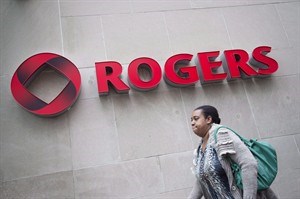
A pedestrian walks past the Rogers Building in Toronto on Tuesday, April 22, 2014. THE CANADIAN PRESS/Darren Calabrese
Republished October 23, 2014 - 2:40 PM
Original Publication Date October 23, 2014 - 8:00 AM
TORONTO - Rogers Communications Inc. profits dropped 28 per cent in the third quarter as the telecommunications company faced trouble attracting and holding subscribers and increased ramp-up costs in its media division related to the new hockey season.
However, chief executive Guy Laurence said Thursday that he expects advertisers and customers to line up for its National Hockey League coverage. The company paid $5.2 billion for the Canadian rights to NHL games for 12 years.
"Now the season has started, revenue will flow in advertising and we can also engage cable and wireless customers in a conversation that is beyond pure price," Laurence told analysts in a conference call.
"This will take time ... but I do believe it will make a real difference."
The Toronto-based cable and wireless company (TSX:RCI.B), which also owns one of Canada's largest media businesses, reported $332 million of net income, or 64 cents per share — down from $464 million, or 90 cents per share.
Adjusted profits were equal to 78 cents per share, which was six cents below analyst estimates compiled by Thomson Reuters. Revenue increased one per cent to $3.25 billion, coming within analyst expectations.
Rogers has been working on a multi-year plan to improve its results, including a reorganization of operations under the leadership of Laurence, who said the third-quarter results came within his expectations.
The company is reaffirming its guidance for 2014 but says adjusted operating profit and free cash flow will likely be at the lower end of the range.
Within the quarterly results, wireless revenue grew two per cent to $1.88 billion, and Rogers added 17,000 new postpaid subscribers, a smaller amount than last year.
Cable revenue slipped one per cent to $864 million as the company lost 30,000 TV subscribers and faced more pricing competition.
Rogers — which has Canada's largest base of mobile phone subscribers and one of the country's largest cable and Internet operations — has been losing market share to long-time rivals Bell, owned by BCE Inc. (TSX:BCE), and Telus (TSX:T).
The media division, which houses Rogers' print and digital publications, TV and radio stations and the Toronto Blue Jays, reported flat revenues of $440 million.
Expenses grew by eight per cent as the company booked $6 million in costs to prepare for the hockey season, another $6 million to help grow its Next Issue Canada digital magazine subscription business and $10 million in higher baseball player salaries.
Rogers has been investing in its new hockey rights with the unveiling of a flashy Hockey Night in Canada studio housed in the CBC building in downtown Toronto and the infrastructure behind the NHL GamePlus mobile app, which offers multiple camera angles that users can interact with through the software.
Marketers and advertisers have responded to the efforts, and fourth-quarter time slots and space for advertising is "already well on the way to being sold out," Laurence said.
While Rogers drums up attention for the new hockey season, it's also facing some opposition from one of its rivals.
Earlier this week, Bell's parent company filed an application with the broadcast regulator that included concerns over the NHL GamePlus app.
Bell told the CRTC that it believes the app violates certain regulatory rules that require content created for broadcasters to be made available to all competitors. The company said the app should be made available for free to all NHL GameCentre Live subscribers, not just Rogers customers.
Rogers has said the features, which include cameras mounted on the helmets of referees, were created for an interactive platform and wouldn't have been developed solely for TV broadcasts — therefore are exempt under the rules. The company has until Nov. 20 to respond formally to the complaint.
Laurence called Bell a "crybaby" for turning to regulators over the disagreement.
"They are complaining and trying to stifle innovation in hockey instead of actually applauding it, which is what we see from pretty much everybody else," he said.
"Obviously we don't believe that we have transgressed any rules and we will continue to focus on delivering innovation for consumers and not fighting little petty fights such as this. I don't think they will win. Let's see."
Laurence also told analysts he is "not seeking to get a lot of revenue" from the app, but considers the product akin to flying business-class on an airline, where coach customers have the option to upgrade for a price.
The former Vodafone UK CEO, who joined Rogers last December, has made changes intended to improve the company's long-term performance. Over the past few months, Rogers has reduced layers of management and cut the number of executives ranked vice-president and above by 15 per cent.
"It is not a trivial exercise but it is now complete," Laurence said.
Canaccord Genuity analyst Dvai Ghose called the quarterly results disappointing overall, particularly when it came to margins in the cable and media divisions and the ability to keep its wireless customers from leaving for another provider.
"Churn was much higher than expected and may take a long time to fix," he wrote in a note.
"While Rogers reiterated 2014 financial guidance, it expects to come in at the low end, and we wonder if it can."
Rogers shares closed down 63 cents or 1.45 per cent at $42.80 Thursday on the Toronto Stock Exchange.
— Follow @dj_friend on Twitter.
News from © The Canadian Press, 2014